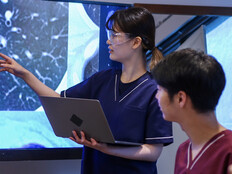Google Glass Explorers Share Experiences at Colleges Across America
Google Glass has garnered much publicity over the past six months as more people have gotten their hands on the device. As with any technology, the real value generally lies somewhere between the hype and the criticism.
One of the most important attributes of a new technology is ease of use. Navigating the menus and submenus in Glass is difficult initially but intuitive after some experimentation. Sharing content via Twitter or Google+ is easy.
Glass makes it easy to record video or take pictures inconspicuously. However, the ease with which this content can be shared online heightens unwilling participants’ concerns. Wearables such as Glass are going to result in a readjustment of social norms. Camera phones are still pushing the boundaries of what is appropriate behavior and challenging the status quo regarding news reporting and copyright infringement.
Consequently, Glass explorers have been navigating a largely uncharted social landscape, using technology that is on the edge of cultural norms.
“Although I wear Glass in public nearly all of the time, I am conscious of times that it pushes the edge too far,” said Melissa Woo, chief information officer at the University of Oregon. “Fortunately, the only reactions I’ve received that seem to border on negative have been from other CIOs! Reactions from strangers in public, as well as on campus, have largely been positive and/or curious — at times exuberant!”
Looking at the World Through Glass
The real question seems to be, “Can I use this at my university, and if so, how?”
Students and faculty at Ohio Wesleyan University can try out Glass by reserving the device for short periods. Some instructors, including Chris Wolverton of OWU's Botany and Microbiology Department, have been using Glass in classroom, lab and field environments.
“One of the struggles of teaching lab techniques is helping students visualize how to do something,” Wolverton said. “I'm eager to use Glass to produce videos that capture a real first-person perspective to working in the lab, so that things seem more familiar when they're actually there doing the experiment.”
The Office of Admission demonstrates the device informally to prospective students during campus visits. Projects are also underway to capture unique experiences in the Athletics and Advancement divisions, as well.
At the University of Oregon's School of Journalism and Communication, Professor Tiffany Gallicano is using Glass in the classroom to help improve student presentations. The school’s Office of the CIO hopes to use Glass’s geographical information system (GIS) applications, and staff are working to develop a grant proposal that incorporates wearables such as Glass into research on higher brain functions.
Other applications of Glass are aimed at facilitating education. STEMbite, created by Andrew Vanden Heuvel, uses clips recorded with Glass to illustrate a particular topic. For example, he explains the polarization of light with a short video — and a bit of humor — to keep viewers interested.
“Rather than trying to teach all the content through the video, my goal is to get the student interested enough that they want to learn more,” Vanden Heuvel said.
Ball State University is pursuing a project to create a companion app (also known as Glassware) for a mobile app developed last year. Dubbed The Traveler (@TheTravelerApp), the mobile app has journeyed across five continents with students studying abroad. The goal of Traveler is to serve as a hands-free connection to the app on a student’s mobile device.
Kyle Parker conceived Traveler after watching 20 college students use the app on a 10-inch tablet for a couple of weeks.
While traveling across Europe and North Africa, he witnessed students experiencing the world through the frame of the small tablet. Rather than taking in the sights around them, the students were digging through their bags for their tablets, framing the perfect shot and tapping away on the keyboard to record what they saw.
Parker wanted to use Glass to have them experience the moment and not be distracted by technology. Glassware will allow students to easily capture photos and annotate them with voice.
Is It Ready?
Google Glass certainly creates new opportunities, but social concerns, privacy, battery life and user interface issues must be addressed before the innovation is more fully accepted in higher education environments. There are clear examples of successful integration of Glass in education, but the technology is not ready for mainstream adoption on most campuses.








